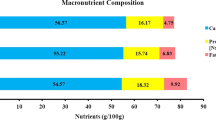Abstract
The protein quality of Nigerian traditional diets based on the African yambean (AYB) and pigeon pea (PP) were performed by in vivo and in vitro bioassays. The individual foods were processed, cooked, dried and mixed to resemble the traditional diets. Weanling male Wistar rats (45–55 g) were used for the bioassay. The rats were fed ad libitum for 35 days of which 28 days were for growth and 7 days for N-balance. All the eleven diets including casein (control) provided 1.6 g N/100 g diet. The parameters tested include PER, growth, N-balance, BV, NPU and apparent digestibility (AD). The rats fed the AYB diets, except AYB: Agidi (Ag), showed superiority in most of the parameters tested. There were significant positive correlations between PER and NPU (r=0.925;p<0.001); PER and AD (r=0.908;p<0.001); PER and body weight gain (r=0.969;p<0.001). The in vitro protein digestibility of the diets was significantly correlated (r=0.80;p<0.01) with the in vivo apparent digestibility. These parameters were used to rank the various diets. Crayfish protein was a better supplement to legume/cereal or legume starchy staple mixtures than leguminous oil seed. However, supplementation of PP: steamed corn (SC) diet with crayfish did not prove beneficial. The result showed that diets based on the African yambean, an under-exploited legume, are nutritious. The need for its reintroduction into the fare of the populace through increased production and appropriate processing technology is stressed. The results of this study can form a base for the standardization of Nigerian diets based on these legumes.
Similar content being viewed by others
References
Achinewhu SC (1983) Chemical and nutrient composition of fermented products from plant foods. Nig Food J 1: 116–118.
Anneger JC (1974) Protein quality of West African food. Ecol Food Nutr 3: 125–130.
AOAC (1984) Official method of analysis, 14th edn. Washington, DC: Association of Official Analytical Chemists.
Ene-Obong HN (1984) Market index, consumption patterns and contribution of cowpea/legumes to the nutrient intakes of selected communities around Nsukka. Masters degree thesis, Department of Home Science and Nutrition, University of Nigeria, Nsukka, Enugu State, Nigeria.
Ene-Obong HN, Carnovale E (1992) A comparison of the proximate, mineral and amino acid composition of some known and lesser known legumes in Nigeria. Food Chem 43: 169–175.
Hsu HW, Vavak DL, Satterlee LD, Miller GA (1977) A multi-enzyme technique for estimating protein digestibility. J Food Sci 42: 1269–1273.
Jaffe WG (1950) Biological value of some legumes important in Venezuelan diet. Arch Venez Nutr 1: 107–112.
Millward DJ, Garlick PJ (1972) The pattern of protein turnover in the whole animal and the effect of dietary variations. Proc Nutr Soc 31: 257–263.
Nnanyelugo DO, King J, Ene-Obong HN, Ngoddy PO (1985) Seasonal variation and the contribution of cowpea (Vigna unguiculata) and other legumes to nutrient intakes in Anambra State, Nigeria. Ecol Food Nutr 17: 271–287.
Obizoba IC (1983) Growth and nitrogen utilization of rats fed pigeon pea — rice mixtures. Nig J Nutr Sci 4: 35–40.
Obizoba IC (1985) Evaluation of the protein quality of rice supplemented with beans or crayfish in rats. Qual Plant Plant Food Hum Nutr 35: 43–49.
Pike RL, Brown MC (1975) Nutrition: an integrated approach, 2nd ed. New York: John Wiley.
Rothschild MA, Oratz M, Mongelli J, Fishman L, Schreiber SS (1969) Amino acid regulation of albumin synthesis. J Nutr 98: 395–403.
Salunkhe DK, Chavan JK, Kadam SS (1986) Pigeon pea as an important food source. CRC Crit Rev Food Sci Nutr 23: 103–145.
Scrimshaw NS, Young VR (1972) Clinical methods for the evaluation of protein quality. In: Bigwood BJ (ed), Protein and amino acid functions. New York: Pergamon Press, pp 363–380.
Sivaraman E, Monachery M (1967) Studies on the nutritive value of cowpea (Vigna catjang) and tur dhal (Cajanus cajan). Int Vet J 44: 162–168.
Ubani UGI, Williams CS, Chung RA (1980) Essential amino acid content of some selected Nigerian meals. J Food Sci 45: 1363-.
Waterloo JC (1969) The assessment of protein nutrition and metabolism in the whole animal with special reference to man. In: Munro HN (ed) Mammalian protein metabolism. New York: Academic Press, pp 326–390.
Author information
Authors and Affiliations
Rights and permissions
About this article
Cite this article
Ene-Obong, H.N., Obizoba, I.C. Protein quality of some Nigerian traditional diets based on the African yambean (Sphenostylis stenocarpa) and pigeon pea (Cajanus cajan). Plant Food Hum Nutr 48, 297–309 (1995). https://doi.org/10.1007/BF01088489
Received:
Accepted:
Issue Date:
DOI: https://doi.org/10.1007/BF01088489




